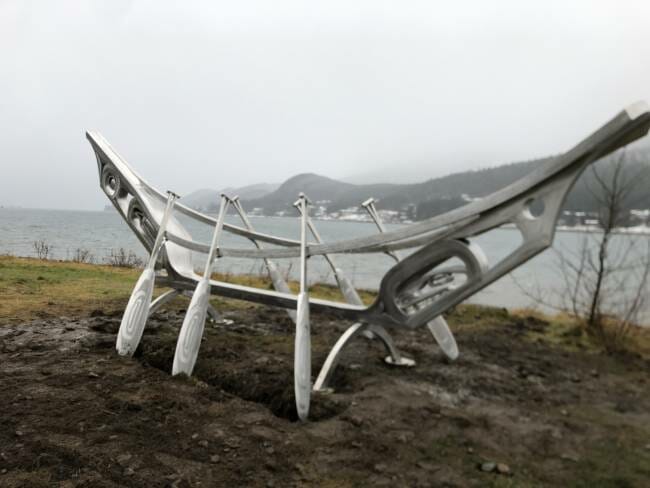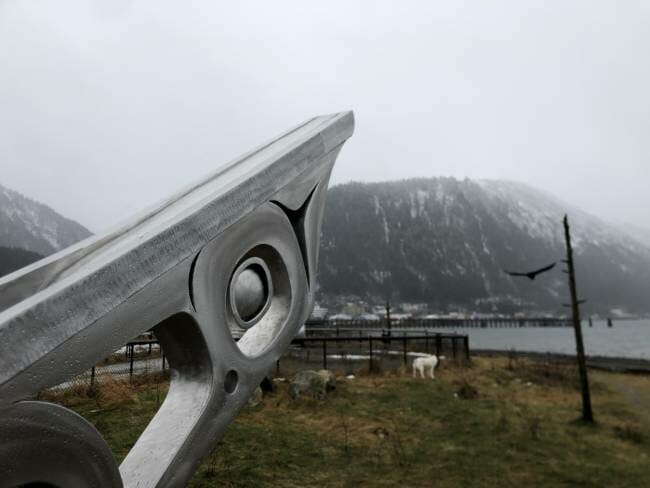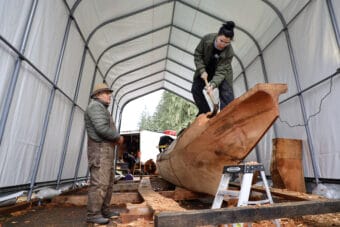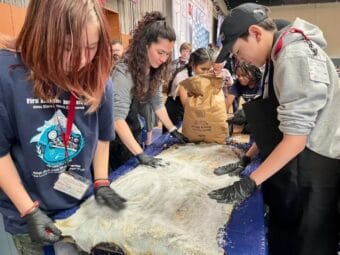
Lingít artist Robert Mills’ head is always up in the clouds, dreaming about projects. A canoe was one of those dream projects.
It came to life through a Juneau CARES ArtWorks grant. During the pandemic, the city set aside some of its federal CARES Act money to provide work for artists. This canoe was one of 35 projects that received funding, this one receiving $37,250.
The 20-foot sculpture is all aluminum — a silver outline of a boat with formline designs on the bow and stern. From the seawalk at Overstreet Park, the shiny metal stands out against the mountains and the Gastineau Channel.
The canoe is a representation of Lingít society. On one level, it represents the vessel that Lingít people used to travel. On another, it represents the binary of the Eagle and Raven and being in harmony with the opposite clan.
On a third level, Mills said it represents the world we live in today.
“Because, you know, certainly coming out of some very contentious times in society, where we have seen some of the worst ills of humanity kind of play themselves out, that void is represented in the canoe sculpture by the negative space that normally would possess the body of the canoe,” Mills said.
In creating formline, Mills said that the negative space is used to help fill the positive. He compared the principle to this period of the pandemic.
“Going forward, we can only hope that we use this negative period and can form it in a way that helps us shape the positive,” Mills said.
Throughout Mills’ life, whether it was growing up in Kake or commercial fishing, he always found ways to make do with what he had.
He said that mentality applied to making this canoe.
“It was a lot of research and development, as far as applying what pressure where, at what points, at how many pounds. You know, bending it one way, going back the other. Just, man, it, it was a lot,” Mills said.
He partnered with fabricator Brian Crapo to mold the metal and bring the piece to life. The completed canoe, named Yaadachóon, hasn’t had a permanent home until now. It spent some of the pandemic in an empty store at the Nugget Mall. It was most recently at Centennial Hall, where it served as a backdrop for musicians who performed at the Indigenous music festival Rock Aak’w.
Now, the canoe is permanently installed along the walkway in Overstreet Park at the original mouth of Gold Creek, or Dzantik’i Heeni.

“You know, I think it’s pretty fitting in that, at one point, it used to possess many, many, many canoes,” Mills said.
Eventually, there will be lights that light up the canoe at night, but the Juneau Arts and Humanities Council is still raising money for that, so they are not installed yet.
In the past couple of years, the city has been investing more in Native public art, with the Elizabeth Peratrovich mural, the formline signs throughout downtown and now this canoe.
Mills said it’s important to highlight Native artists, especially as they have been historically suppressed in their own lands.
“You know, when you grow up not seeing some of this artform that resides in, you know, some of the finest art collections in the history of the world, Lingít art stands next to them, and yet growing up you don’t see that in your own homeland,” Mills said.
To Mills, gaining more representation in art is a step in the right direction. With more Native public art, Native children can look up at these works and be inspired to become artists themselves one day.


